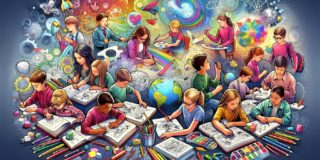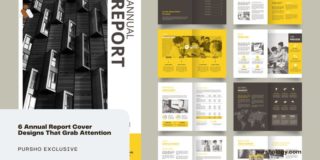To create the images shown above, I entered the words “half brain half technology watercolor shapes dark” in Canva’s text to image AI generator. It took about 1 minute to get a customized image.
Artificial Intelligence is expanding the horizons of technology-fueled creativity. It is also changing the presentation design world in new and exciting ways, and today we want to explore these innovations. We’ll start with a quick overview of AI technology, and then we’ll jump into how a couple of the presentation giants are using it.
What is AI?
In recent months, AI-generated images have been increasing in popularity. Maybe you saw the music video created by combining Michael Jackson’s “Thriller” song lyrics with AI-generated images. But how does it work?
According to builtin.com, here’s what’s going on behind the scenes. “Most tools start with researchers feeding them millions and millions of images. They also annotate these data sets, providing the machine with a text reference. Then the device is tweaked, calibrated and trained until it can consistently recognize those photos. After a while, it can begin to parse the difference between varying images, and generate its own with some accuracy.” So when you or another other user “enters a text input into the tool (“bunny in a raincoat painted in the style of Frida Kahlo,” for example)…the tool spits out a creation that closely represents the image described.” So AI-generated designs combine your input of search terms, or “prompts,” which describe what you want to see with the computer’s output of learned responses for what that might look like.
How Are Presentation Companies Are Using It?
So we know that creatives are using this new technology to produce stunning artwork, but here are some of the ways AI is changing the world of presentation design.
Beautiful.ai: DesignerBot
Beautiful.ai is a subscription-based presentation design program that offers AI-generated images and presentations via DesignerBot. They say, “Describe the presentation you want, and we’ll generate a beautiful deck with story, content and visuals already in place. Built on Smart Slides that auto-adapt as you edit, it couldn’t be easier to further customize.”
So in theory, you could pull up a blank screen and type in something like “payment processing sales pitch high contrast modern shapes” and generate a slide deck of 10-20 slides that match those criteria. Once inside the custom template, you can edit and add specific elements as needed. Beautiful.ai says, “This is the power of generative AI and the game-changing experience it enables by cutting down the time users spend designing their story and giving them more time to tell it.” Sounds pretty dreamy, right?
Canva: Text to Image
Graphic design giant Canva has also jumped on the AI bandwagon. Their text to image function allows you to enter a prompt and pull back AI-generated images. Johnathan Wylie of Bootcamp UX Design says, “Canva’s AI image generator is based on a technology called Stable Diffusion, an open source text-to-image model that is capable of generating photo-realistic images for whatever you want to create a picture of. The app is part of Canva’s design suite, so you do need a Canva account to use it. However, it works with both free and paid accounts, so everyone can give it a try to see what it can do.”
As with most of these programs, this new technology still has some hiccups. For now, Canva will only generate square AI-generated images. In addition, Canva doesn’t offer the kind of presentation template generation that other programs like beautiful.ai and PowerPoint have. It currently works better for generating single custom images. But again, this technology is only in its beginning stages.
PowerPoint: Designer
Microsoft’s PowerPoint program has its own AI generator called Designer. Launched at the beginning of 2016, it has been helping “people create visually engaging and immersive presentations with only a few clicks.” Microsoft says, “Designer’s AI chooses the most suitable layouts for the content, intelligently crops images, and automatically recommends relevant icons and pictures.” One of the more recent additions to their AI capabilities is the ability to use Designer in tandem with your own branding. Microsoft says, “Now users can get this streamlined experience while working within their organizations’ templates.” This technology has the potential to save presenters and designers time and money. Not to mention, it keeps them out of the dreaded abyss of image and template libraries.
XR design manger at Unity, Manuel “Manu.Vision” Sainsily has a hopeful outlook for AI in presentation design. Sainsily shared with Fast Company that he “believes that this technology will lead to a renaissance, much like we have experienced before with other technical revolutions, like digital video editing, desktop publishing, or photography. We have been remixing for centuries. This AI technology just makes the process faster. And yes, that will bring a lot of change to the industry but, as with other revolutions, it will also offer incredible opportunities.”
Today we wanted to give you an overview of how AI is changing presentation design. Check back next week when we’ll cover some specific ways you can start using AI in your own slide decks.
Ethos3 can help with all your presentation needs. From design to delivery, we’ve got you covered. See how we can help you take your presentation to the next level.
The post How AI is Changing Presentation Design appeared first on Ethos3 – A Presentation Training and Design Agency.
Looking For Powerpoint Design Agency?
Call Pursho @ 0731-6725516
Telegram Group One Must Follow :
For Startups: https://t.me/daily_business_reads
#Changing #Presentation #Design



